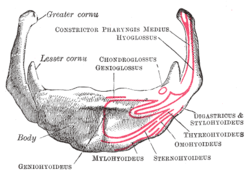Middle pharyngeal constrictor muscle
| Middle pharyngeal constrictor muscle | |
|---|---|
 | |
 Muscles of the pharynx, viewed from behind, together with the associated vessels and nerves (middle pharyngeal constrictor muscle labeled as Mid. constr. at center) | |
| Details | |
| Origin | Hyoid bone |
| Insertion | Pharyngeal raphe |
| Artery | Ascending pharyngeal artery |
| Nerve | Pharyngeal plexus of vagus nerve |
| Actions | Swallowing |
| Identifiers | |
| Latin | Musculus constrictor pharyngis medius |
| Dorlands /Elsevier | m_22/12548641 |
| TA | A05.3.01.108 |
| FMA | 46622 |
The middle pharyngeal constrictor is a fanshaped muscle located in the neck. It is one of three pharyngeal constrictors. Similarly to the superior and inferior pharyngeal constrictor muscles, the middle pharyngeal constrictor is innervated by a branch of the vagus nerve through the pharyngeal plexus. The middle pharyngeal constrictor is smaller than the inferior pharyngeal constrictor muscle.
Structure
The middle pharyngeal constrictor arises from the whole length of the upper border of the greater cornu of the hyoid bone, from the lesser cornu, and from the stylohyoid ligament.
The fibers diverge from their origin: the lower ones descend beneath the constrictor inferior, the middle fibers pass transversely, and the upper fibers ascend and overlap the constrictor superior.
It is inserted into the posterior median fibrous raphe, blending in the middle line with the muscle of the opposite side.
Function
As soon as the bolus of food is received in the pharynx, the elevator muscles relax, the pharynx descends, and the constrictors contract upon the bolus, and convey it downward into the esophagus.[1][2] They also have respiratory mechanical effects.[3]
Additional images
 Hyoid bone. Anterior surface. Enlarged.
Hyoid bone. Anterior surface. Enlarged. Muscles of the neck. Lateral view.
Muscles of the neck. Lateral view.- Middle pharyngeal constrictor muscle
- Middle pharyngeal constrictor muscle
- Deep dissection of larynx, pharynx and tongue seen from behind
- Deep dissection of larynx, pharynx and tongue seen from behind
- Deep dissection of larynx, pharynx and tongue seen from behind
References
This article incorporates text in the public domain from the 20th edition of Gray's Anatomy (1918)
- ↑ Rowe LD, Miller AJ, Chierici G, Clendenning D (August 1984). "Adaptation in the function of pharyngeal constrictor muscles". Otolaryngology-Head and Neck Surgery. 92 (4): 392–401. PMID 6435057.
- ↑ Donner, Martin W.; Bosnia, James F.; Robertson, Diane L. (1985). "Anatomy and physiology of the pharynx". Gastrointestinal Radiology. 10 (1): 197–212. ISSN 0364-2356. doi:10.1007/BF01893103.
- ↑ Kuna, Samuel T (2000). "Respiratory-related activation and mechanical effects of the pharyngeal constrictor muscles". Respiration Physiology. 119 (2-3): 155–161. ISSN 0034-5687. doi:10.1016/S0034-5687(99)00110-3.
Further reading
- Its role in speech: Hamaker, Ronald C.; Blom, Eric D. (2003). "Botulinum Neurotoxin for Pharyngeal Constrictor Muscle Spasm in Tracheoesophageal Voice Restoration". The Laryngoscope. 113 (9): 1479–1482. ISSN 0023-852X. doi:10.1097/00005537-200309000-00010.
- Its role in Hyoid bone syndrome: Ernest, Edwin A.; Salter, E. George (1991). "Hyoid bone syndrome: A degenerative injury of the middle pharyngeal constrictor muscle with photomicroscopic evidence of insertion tendinosis". The Journal of Prosthetic Dentistry. 66 (1): 78–83. ISSN 0022-3913. doi:10.1016/0022-3913(91)90357-3.
External links
- lesson8 at The Anatomy Lesson by Wesley Norman (Georgetown University) (latpharyngealitems3)